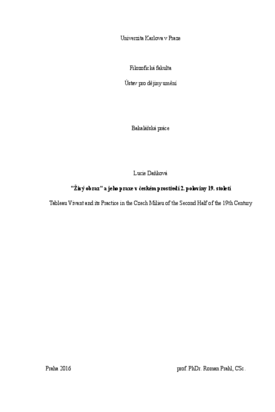"Živý obraz" a jeho praxe v českém prostředí 2. poloviny 19. století
Tableau Vivant and its Practice in the Czech Milieu of the Second Half of the 19th Century
bakalářská práce (OBHÁJENO)

Zobrazit/
Trvalý odkaz
http://hdl.handle.net/20.500.11956/78209Identifikátory
SIS: 164527
Kolekce
- Kvalifikační práce [23715]
Autor
Vedoucí práce
Oponent práce
Rakušanová, Marie
Fakulta / součást
Filozofická fakulta
Obor
Dějiny umění
Katedra / ústav / klinika
Ústav pro dějiny umění
Datum obhajoby
1. 6. 2016
Nakladatel
Univerzita Karlova, Filozofická fakultaJazyk
Čeština
Známka
Výborně
Klíčová slova (česky)
živý obraz, divadlo, ateliérová fotografie, piktorialismus, Národní divadlo, Sokol, šlechtické slavnosti, žánrová malba, imitace, 19. stoletíKlíčová slova (anglicky)
Tableau Vivant, Theatre, Studio Photography, Pictorialism, National Theatre in Prague, Sokol, Aristocratic Celebrations, Genre Painting, Imitation, 19th CenturyPráce se věnuje fenoménu takzvaných živých obrazů, mezinárodně často známých pod francouzským překladem slovního spojení - tableaux vivants (v singuláru tableau vivant). Jde o typ divadelního představení a parateatrální žánr, předváděný aktéry v kostýmech, kteří na krátkou dobu strnule drží určitou pozici tak, aby se celá scéna podobala uměleckému dílu - již podle názvu nejčastěji obraz. Jako předlohy pro kompozici scény byly vybírány známé malby (dobové obecenstvo se pak bavilo jejich poznáváním a iluzí "oživlého" obrazu, kterou na něj inscenace působila), ale i sochy; někdy byly výjevy navrhovány zcela nově, například v případě takzvané apoteózy (živého obrazu určeného k oslavení určité osobnosti), či různých alegorií, v českém prostředí často s vlasteneckým podtextem. Živý obraz měl tedy mnoho podob, a také řadu nejrůznějších funkcí - zábavní, estetickou, sdělovací, či například reprezentační, související zejména se šlechtickými rody a u nás velmi výrazně s organizací Sokol. Pozornost je zaměřena na "zlatý věk" živých obrazů, tedy 19. století, a to konkrétně na jeho druhou polovinu v kontextu českého prostředí. Rozdělení do kapitol ovšem typologicky reflektuje celoevropsky realizované druhy tableaux, o kterých je vždy pojednáno nejprve obecně s uvedením reprezentativních příkladů ze světa, a...
The thesis explores the phenomenon of so-called living pictures, often internationally known under the French translation of the phrase - as tableaux vivants (in singular form a tableau vivant). It is a type of theatrical performance and a paratheatrical genre performed by participants in costumes who, for a short time, motionlessly maintain a certain position, so that the whole scene resembles a work of art - most often a picture, as the term suggests. As templates for the scene composition were selected famous paintings (contemporary audience then amused themselves by identifying them and by the illusion of the picture "brought to life", which the production evoked), but also sculptures; some scenes were designed from scratch, as in the case of so-called Apotheosis (a living picture meant for glorification of a certain personality) and various allegories, in the Czech milieu often with patriotic overtones. A living picture therefore had many forms, and also a variety of different functions - entertaining, aesthetic, communicating or for instance representational, which is associated with aristocratic families in particular and in our lands very considerably with the Sokol organization. Attention is focused on the "golden age" of living pictures, i.e. the 19th century, specifically in its second...
